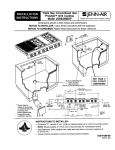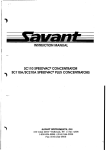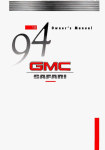Download Jenn-Air Dual Fuel Cooktop Range User Manual
Transcript
EXPRESSIONS WUENN-AIR DUAL FUEL COOKTOP 403 WEST FOURTH STFtEET, flORTHeflE3NTON tAS0208 IMPORTANT: Installation should be performed only by a Jenn-Air Authorized Servicer or other qualified installer. Read safety precautions in the Use & Care Manual before using this appliance. imensions shown in beth inches and centimeters.) • 31 7/8" +1 [80.96 ¢m] 9/16" _:1/16" [52.23 cm] 7/8" 22.54 crn_ 36.67 2 1/4 ° MIN. GAS CONNECTION AXIS -'7 I 8 7/8" [22.54 ¢m] [2.54 ¢m] MIN. CLEARANCE [5.71 5 13/16 ° [ 20.64. 20.30 cm] CUTOUT DIMENSIONS cm] SELECT ARE CRITICAL APPROPRIATE DUCT CUTOUT (SEE DUCTI NO OeTUO. I NSTRUCT = 32 3/8" [82.23 cm] IONS. ) - i • [11.75 "I co _] cm] _[4.4.4 cm] TO 1/2" NPT EXT. THREADEDNIPPLE N FOR COOLING PURPOSE. 1 [31.76 cm] • Side Clearance - Unit may be safely installed as near as 2" (5.08 cm) from a side wall if space limitations require. However, a side clearance of at least 6" is recommended for optimum ventilation. INSTRUCTIONS TO INSTALLER: SAVE THESE INSTRUCTIONS FOR FUTURE REFERENCE 8101 P289-60 (ol -98-o0) Location Of Your Jenn-Air Appliance Preparation Of Countertop Locatethis appliance away from combustible materials such as window curtains and combustible wall decorations. The minimum horizontal clearance between the edge of the appliance and adjacent combustibleconstruction is: • 0.75 inches (1.90 cm) at rear; • 2 inches (5.08 cm) at sides The cutout in the countertop intowhich the appliance is to be installed should be prepared according to the cutout dimensions given on page 1 of these instructions. CAUTION: Cutout dimensions are critical. Dimensionsmust be measured and cut accurately to within + 1/16" to ensure proper fit. These minimum clearances pertain to vertical surfaces between the countertop level and a level 18" above the countertop. .............................. / Important Installation Suggestions: 1. Chamfer all exposed edges of decorative countertop laminate to prevent damagefrom chipping. / 2. Slightly radius corners of cutout and file to insure smooth edges and prevent corner cracking. 3. Rough edges, inside corners which have not been rounded /' 18" j an ,orce the 4. Unit must be supported on all four sides by the countertop and countertop must be supported within 3" of edge of laminate. cutout. (45.7_ 1 _._ 2. Installation Of Appliance ART_19215-030 Figure 1: Minimum Horizontal Clearance Follow accompanying This applianceisdesignedtoalwaysbeventedoutdoors.This appliance should be ducted separatelyfrom other vented appliances. NOTE:These are not recommendedclearances,but rather the minimum allowable clearances. Overall performance of your cooktop will be enhanced by providing a 6" or greater clearance on either side of the unit. This appliance is designed for use with the gas appliance Installing Cabinetry Over Your Cooktop pressure regulator provided. The installation of this appliance must conform with local codes or, in the absence of local codes, with the latest edition of the National Fuel Gas Code, ANSI Z223.1 USA or current CAN/CGA-B149INSTALLATIONCODE. Observethe following clearancesto overhead cabinetry. t _ ducting instructions carefully, This applianceis designedto operate at a pressureof 5 inches of water columnon natural gasor, ifconverted for use with LP gas (propane or butane), 10 inches of water column. Make sure this appliance is supplied with the type of gas for which B _ This appliancewas adjusted at the factoryfor usewith natural it is designed. gas. If, type of in gas, theall future, of the thisconversion applianceadjustments isto be used described on a different on Figure 2: MinimumClearancestoOverheadCabinetry pages4 and 5 must be made by a servicetechnician or other qualified person before attempting to operate the cooktop on that gas. Naturalgas should besupplied to the appliance at a line pressure between 6 and 14 inches of water column or, if converted for LP gas, between 11and 14 inches. A = 30 inches (76.2 ¢m) minimum vertical clearance between cookingsurface and combustibleconstruction or metal cabinets above the appliance. This clearance may be reducedto not lessthan 24 inches by protecting the underside of the combustible material or metal cabinet above the cooking surface with not less than 1/4-inch insulatingmillboard covered with sheet metal not less than 0.0122-inchthick.* B = 13 inches (33.0) maximum depth of cabinets installed abovecooking surface. WARNING: If the pressure of the gas system supplying this applianceexceeds 14"W.C., an external regulator(not provided) must be installed in the gas line to reduce the systempressureto no morethan 14" W.C.Failuretodo this can result in excessive gasflow and explosion. Make sure your appliance is suppliedwith the type of gas for which it is adjusted and that the gas is being supplied within the appropriate pressure range. CAUTION: Avoid use of cabinets above cooktopfor storage to eliminatepotential hazard of reaching over open flames, *Jenn-Air Over-the-Rangemicrowaveovens (model#M418 and M438)have been listed by ULfor use over Gas and ElectricRanges, When properly installedat aminimumheightof66 inchesfrom the floortothe top ofthe microwave,the clearanceto the cookingsurfaceatthe centerwill be 13-3/4inches. 2 Connecting Appliance To Electricity Connecting Wiring Information Electrical 1. Install a manual shut-off valve in an accessible location the gas line external to this appliance for the purpose shutting off gas supply to this appliance. 2. Install the appliance pressure regulator supplied with th Proper Electric Supply You must provide an adequate electrical supply system as required for your cooktop. All wire connections must be in accordance with local codes and properly insulated. Check with local utility for voerning electrical codes and ordinances, In the absence of local electrical codes, the National Electrical Code, NFPA No. 70, governing electric cooktop installations must be followed. A copy of the National Electrical Codes, NFPA No. 70, can be obtained by writing to: NATIONAL FIRE PROTECTION ASSOC. Batterymarch Park appliance to the threaded gas inlet of the manifold pip( taking care to observe proper direction of gas flow throug the regulator. Tighten to 20 to 30 ft.-Ibs, of torque. 3. Connect the inlet of the appliance pressure regulator to th shut-off valve using a 1/2" NPT pipe nipple of appropriat length and additional pipe fittings, as required. Use an approved pipe joint compound that is resistant to th action of LP gas on all external pipe threads when makin these connections. A three-wire, single phase, A.C. 120/240 volt 60 cycle electrical system (properly circuit protected to meet Local Codes of NFPA No. 70) must be provided. Unit must be properly grounded in accordance with local wiring code. The chart below recommends the minimum circuit protector and Quincy, Massachusetts 02269 wire size if the appliance is the only unit on the circuit. If smaller sizes of wire are used, the unit efficiency will be reduced and a fire hazard may be created. It is advisable that the electrical wiring and hookup be accomplished by a competent electrician. APPL _A,CEPR______ REGULATOR, SUPPL IEO (OBSErvE DIRECTION OFGASFLOW ARROW)I I UNmN PI PE HI PPLE _LEXI BLE.--_.f_ CONNgCTO (5 FT. MAX) FLARE ADAPT UN IONoR-_ SHUT-OFF VALV GAS F_._ 6 _- ___ _ _--GAS SHUT-OFF VALVE _ P I PE __ _1"/--1/2" NPT P_PE 1/2" NPT_ Figure 4: Alternative Gas Connections A new, A.G.A.-certified, flexible metal appliance connector 4.) The flexible connector should have a diameter of 1/2" flare union adapter is required at each end of the flexible connector. CAUTION: not attempt to attach tothe connector may be usedDo to connect this appliance the flexible gas supply (figure directly to an external pipe thread. " .__ t_ _2" ,_T APPL IANCE Remove attachmentscrew and cover from junctionbox. Connect BX cable power supply to knockout in side of box. Make wire connections, push wires into box. Re-attach cover. Consult local codes for proper power hookup. (Figure 3). ._ I I FLARED_ WIRE SIZE, AWG 12 10 8 8 60 } ADAPT RECOMMENDEDMINIMUM 12.0 - 14.9 To Gas Supply A TRAINED SERVICEMAN OR GAS APPLIANC INSTALLER MUST MAKE THE GAS SUPP[ CONNECTION. Leak testing of the appliance shall t conducted by the installer according to the instructior given. The neutral of this unit is grounded to the frame through the green grounding wire. If local conditions do not permit grounding of the neutral, untwist or disconnect the green wire and connect the green wire to ground in accordance with local codes. Connect the white neutral to the service neutral. K.W. RATING CIRCUIT PROTECTION ON SERIAL PLATE IN AMPRES 0- 4.9 20 5.0- 6.9 30 7.0- 9.9 40 10.0 - 11.9 50 Appliance ,_/ IMPORTANT (_ Apply a non-corrosive leak detection fluid to all joints and fittings in the gas connection between the supply line in the valve rangeand if the connections were shut-off range. Include gas disturbed fittings andduring joints Box 4× fittings and Check installation. connections for leaks! will bubbles indicate appearing a leak. If around a leak appears, turn off supply line gas shut-off valve, tighten connections, turn on the supply line gas shut off valve, and retest for leaks, Never test for gas leaks with an open flame. CABLE j/ F lure 3 3 NOTE: In Canada, gas utilization codes prohibit use of street elbows. Use standard pipe elbows and make modifications to these instructions as necessary, Step 3: Trim a small piece of masking tape to the size of a dime and affix it over the end of a 5/16" nut driver. Pressure Testing Step 4: Firmly press the nut driver over the orifice spud (figure 5) and loosen spud by turning counterclockwise. Carefully lift nut driver out of burner throat. Orifice spud should be captured in the recess. Repeat this step for each burner. This appliance must be isolated from the gas supply piping system by closing its individual manual shutoff valve during any pressure testing of the gas supply piping system at test pressures equal to or less than 1/2 PSIG (2.5 k pa). This appliance, as well as its individualshutoff valve, must be disconnected from the gas supply piping system during any pressure testing of the system at test pressures in excess of 1/2 PSIG (3.5 k Pa). ALUMfNUM VENTURI 5/16 mNUT DRIVER When checking for proper function of the appliance pressure regulator, make certain pressure of natural gas supply is between 6 and 14 inches of water column or, if converted for LP gas, between 11 and 14 inches. BURNER BASE P_ECE TAPE STUCK Or MASK_NC TO END oF DRIVER I GNI TEn Converting Appliance For Use With LP Gas ORIFICE WARNING SPUD Figure 5: Removalof Orifice Spud Propane conversion is to be performed by a JENN-AIR AUTHORIZED SERVICER (or other qualified agency) in accordance with the manufacturer's instructions and all codes and requirements of the authority having jurisdiction. Failure to follow instructions could result in serious injury or property damage. The qualified agency performing this work assumes responsibility for this conversion, I Electrical power and gas must be turned off prior to conversion. WARNING This appliance was adjusted at the factory for use with natural gas. To convert it for use with LP gas (propane or butane), both of the following modifications must be performed: A. Replace all orifice spuds Step 1: Remove the grates and burner heads. Step 2: Remove aluminum venturi tube. Step 5: Locate the LP orifice spud packet taped to the underside of the burner box. The spuds have small numbers stamped on the side. This number codes the orifice diameter and its correct burner location. The following illustrations show correct LP orifice spud location for 4 burner and 5 burner models, respectively. of the nut driver, press an LP orifice spud into the recess so that it is snugly captured. Step 6: With the masking tape still in place in the recess Step7: Carefully install the orifice spud in the appropriate burner throat by turning clockwise to tighten. Tighten to a torque of 15 to 20 inch-lbs. Step 8: Replace cylindrical aluminum venturi tubes. Replace burner heads and grates. Index each grate to its burner pan. Step 9: Save the orifices removed from the appliance for future use. Installation of LP Orifice Spuds With a quarter, engage slot and rotate cap 1/8 of a tL counterclockwise. To remove cap, turn cap over and reinst_ = _ ° . (_ L P"" "_ _ NaturalSetting LP Setting Figure8: Conversionof Harper-Wyman Appliance Pressure Regulator 0 // ART #9215-033-0 00 _ After conversion, steps A and B have been completed, che¢ the appearance of each burners' flame at the Hi and L small, review all steps to make sure they were complete correctly. settings against figure 9. If the flames appear too large or to Figure 6 B. Invert Cap in Appliance Pressure Regulator (See figures 7 and 8.) With the appliance installed, regulator is located on the underside of the burner box on right hand side at the inlet to the gas manifold. Identify make of appliance regulator on the unit and follow the the the the ,.P"-"_gs ' ', ,/ I_1o ,._ 2., I; - 5 6 CAP R._ I _'--_A ND PIN J CONVERTE NAT _jl r LP RER.ACE PININC, AP. ,_ _ FINGER PRESSURE TO_ PIN APPLY SIDEWARD _ _ Figure 7: Conversionof Maxitrol Appliance Pressure Regulator I '± __ _ 7 8 Figure 9: Flame Appearanceat Hi and Lo To Convert Appliance For Use With Installation of Natural Gas Orifice Spuds Natural Gas This appliance is equipped for electronic auto-reignition by If this appliance has been converted for use with LP gas, each of the following modifications must be performed to convert the unit back to natural gas. means of a spark igniter located at the side of each burner. The burners are designed to light at any valve rotation that admits sufficient gas flow to support a flame and to automatically re-light following a momentary loss of flame due to a draft or other adverse condition. This feature is provided as a convenience and is not intended as a safety feature. A. Replace all orifice spuds Perform Steps 1 through 4 on page 4. For Step 5: Locate the colored brass natural gas orifice spudsthatwereoriginallyinstalledinthisappliancebefore its conversion for use with LP gas. Observe the color of each of the spuds and note the correct burner location for each spud as shown in figure 10. Complete Steps 6 through 9 on page 4 to complete the installation of natural gas main spuds in their correct locations. use. They will be needed if this appliance converted for use with LP gas. This appliance has no air shutters, making adjustment of primary air unnecessary. The burners are designed to provide optimum aeration of all gases without air shutters. When operating properly, burners should produce clearly defined, even blue flames. If the flames have yellow tips or are hazy and otherwise appear to have insufficient air, obtain the services of a qualified service technician. is again Save the orifices removed from the Orifice appliance Spuds for future Installation of Natural Gas / BURNER Right Front Right Rear NATURAL GAS PROPANE ALL GASES BURNER RATE BURNER RATE LO RATE (BTU/HR) (BTU/HR) (BTU/HR) 12,000 6,500 8000 4500 1,600 800 Q CAUTION: cover control knobsobjects. or surrounding control surface withNever utensils, towels or other Never obstruct Q free passage the control knobs. The toknob openings haveair been sized past to properly control air entry the interior of Q the appliance during operation. Q © ART #9215-032-0 Figure 10 B. ___ Invert Appliance Pressure Regulator Cap With the appliance installed, the regulator is located on the underside of the appliance at the inlet to the gas manifold. Identify the type of regulator on the unit and follow the instructions in the appropriate illustration. (See figures 7 and 8). After Steps A and B have been completed, check the appearance of each burners' flame at the Hi and Lo settings against figure 9. If the flames appear too large or too small, review all steps to make sure they were completed correctly.










